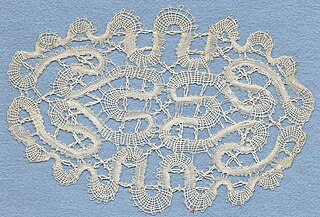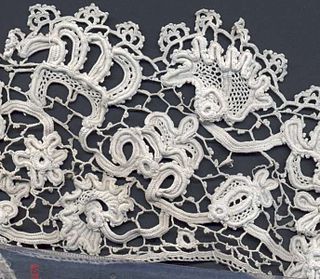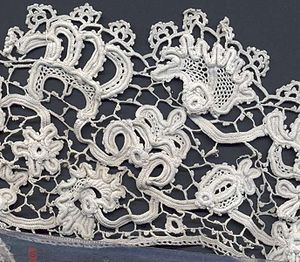
Crochet is a process of creating textiles by using a crochet hook to interlock loops of yarn, thread, or strands of other materials. The name is derived from the French term crochet, meaning 'small hook'. Hooks can be made from a variety of materials, such as metal, wood, bamboo, or plastic. The key difference between crochet and knitting, beyond the implements used for their production, is that each stitch in crochet is completed before the next one is begun, while knitting keeps many stitches open at a time. Some variant forms of crochet, such as Tunisian crochet and broomstick lace, do keep multiple crochet stitches open at a time.

Knitting is a method by which yarn is manipulated to create a textile or fabric; it is used in many types of garments. Knitting may be done by hand or by machine.

Tatting is a technique for handcrafting a particularly durable lace from a series of knots and loops. Tatting can be used to make lace edging as well as doilies, collars, accessories such as earrings and necklaces, and other decorative pieces. The lace is formed by a pattern of rings and chains formed from a series of cow hitch or half-hitch knots, called double stitches, over a core thread. Gaps can be left between the stitches to form picots, which are used for practical construction as well as decorative effect.

Filet crochet is a type of crocheted fabric. This type of crocheted lace is gridlike because it uses only two crochet stitches: the chain stitch and the double crochet stitch. Old filet patterns used a treble or triple stitch vertically but chained two between the vertical stitches. This was to prevent distortion of some patterns. Chain stitches use less yarn than double crochet stitches, which results in a visual difference in appearance between the two kinds of stitch. Filet crochet forms patterns by filling in parts of a mostly chain stitch mesh with double crochet stitches. Filet crochet is usually constructed from monotone crochet thread made of Mercerised cotton in white or ecru, and worked in rows. Filet crochet is used for decorative applications such as window curtains, tablecloths, and place settings such as coasters and placemats.

Lace is a delicate fabric made of yarn or thread in an open weblike pattern, made by machine or by hand.

Macramé is a form of textile produced using knotting techniques.
Broomstick lace, also known as jiffy lace and peacock eye crochet, is a historic crochet technique from the 19th century which is done using a crochet hook and another long slender item such as a knitting needle. Traditionally a broomstick was used, hence the name, but the modern variant is a lightweight plastic knitting needle or smooth wooden craft dowel. A larger knitting needle or dowel will result in a lacier effect, while a smaller will provide a more closely woven effect. Because the fabric created is soft yet stable, it is well-suited for clothing and blankets.

Knitting is the process of using two or more needles to loop yarn into a series of interconnected loops in order to create a finished garment or some other type of fabric. The word is derived from knot, thought to originate from the Dutch verb knutten, which is similar to the Old English cnyttan, “to knot”. Its origins lie in the basic human need for clothing for protection against the elements. More recently, hand knitting has become less a necessary skill and more a hobby.

A doily is an ornamental mat, typically made of paper or fabric, and variously used for protecting surfaces or binding flowers, in food service presentation, or as a head covering or clothing ornamentation. It is characterized by openwork, which allows the surface of the underlying object to show through.
Filet lace is the general word used for all the different techniques of embroidery on knotted net. It is a hand made needlework created by weaving or embroidery using a long blunt needle and a thread on a ground of knotted net lace or filet work made of square or diagonal meshes of the same sizes or of different sizes. Lacis uses the same technique but is made on a ground of leno or small canvas.

Limerick lace is a specific class of lace originating in Limerick, Ireland, which was later produced throughout the country. It evolved from the invention of a machine which made net in 1808. Until John Heathcoat invented a net-making machine in Devon in 1815, handmade net was a very expensive fabric. This meant cheap net became available to Irish lacemakers, particularly after 1823 when Heathcoat's patent expired.

Hairpin lace is a lace-making technique that uses a crochet hook and two parallel metal rods held at the top and the bottom by removable bars. Historically, a metal U-shaped eponymous hairpin was used.

Amigurumi is the Japanese art of knitting or crocheting small, stuffed yarn creatures. The word is a compound of the Japanese words 編み ami, meaning "crocheted or knitted", and 包み kurumi, literally "wrapping", as in 縫い包み nuigurumi "(sewn) stuffed doll". Amigurumi vary in size and there are no restrictions about size or look. While the art of amigurumi has been known in Japan for several decades, the craft first started appealing to the masses in other countries, especially in the West, in 2003. By 2006, amigurumi were reported to be some of the most popular items on Etsy, an online craft marketplace, where they typically sold for $10 to $100.

Net or netting is any textile in which the yarns are fused, looped or knotted at their intersections, resulting in a fabric with open spaces between the yarns. Net has many uses, and comes in different varieties. Depending on the type of yarn or filament that is used to make up the textile, its characteristics can vary from durable to not durable.

A granny square is a piece of square fabric produced in crochet by working in rounds from the center outward. Granny squares are traditionally handmade. They resemble coarse lace. Although there is no theoretical limit to the maximum size of a granny square, crocheters usually create multiple small squares and assemble the pieces to make clothing, purses, Afghan blankets, and other household textiles.

Crochet thread is specially formulated thread usually made from mercerized cotton for crafting decorative crochet items such as doilies or filet crochet. Crochet thread produces fabric of fine gauge that may be stiffened with starch.

Irish lace has always been an important part of the Irish needlework tradition. Both needlepoint and Bobbin-laces were made in Ireland before the middle of the eighteenth century, but never, apparently, on a commercial scale. It was promoted by Irish aristocrats such as Lady Arabella Denny, the famous philanthropist, who used social and political connections to support the new industry and promote the sale of Irish lace abroad. Lady Denny, working in connection with the Dublin Society, introduced lace-making into the Dublin workhouses, especially among the children there. It is thought that it was an early form of Crochet, imitating the appearance of Venetian Gros Point lace.

Bobbin tape lace is bobbin lace where the design is formed of one or more tapes curved so they make an attractive pattern. The tapes are made at the same time as the rest of the lace, and are joined to each other, or themselves, using a crochet hook.

Mary Card was an Australian designer and educator.

Irish crochet lace is a style of Irish lace which is generally considered allied to rather than a true lace. It was originally developed in mid-nineteenth century Ireland as a method of imitating expensive Venetian point laces.

























